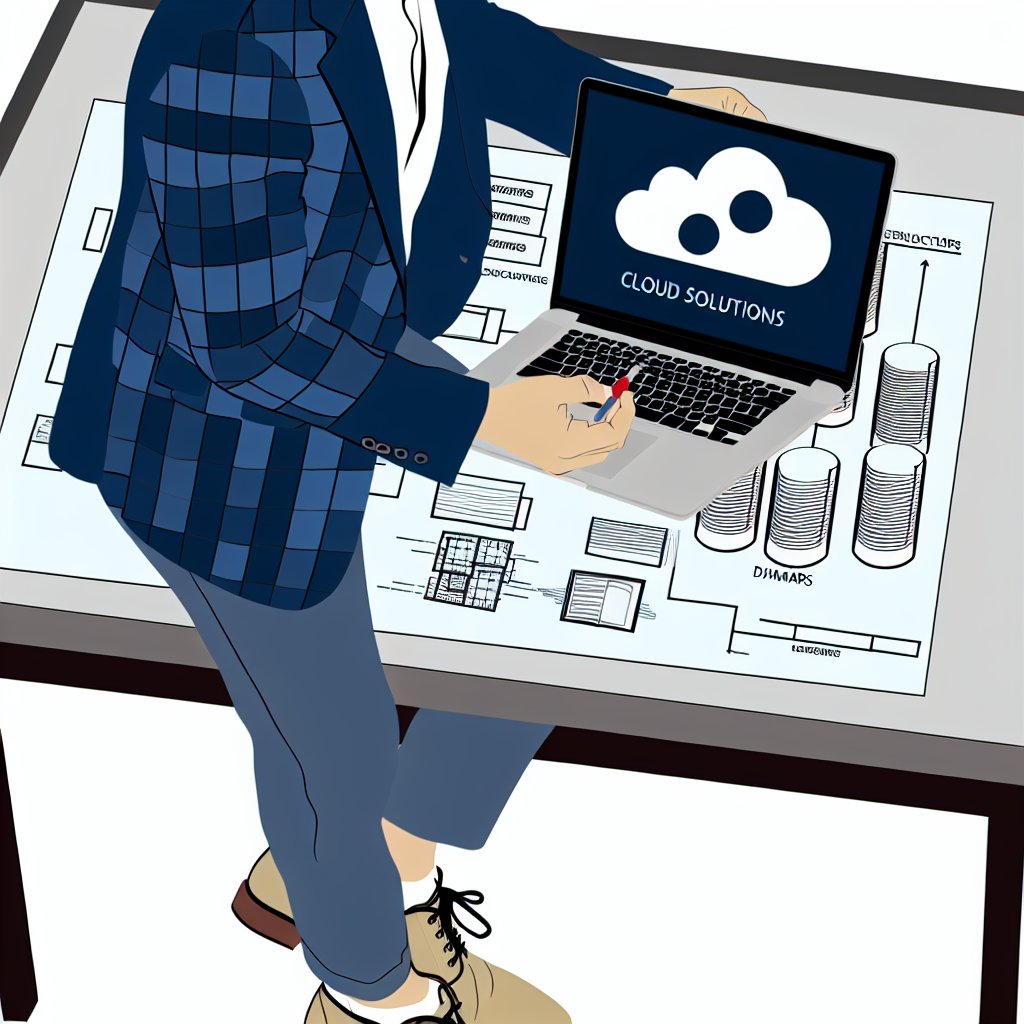Introduction
A Cloud Solutions Architect plays a crucial role in designing and implementing complex cloud solutions for businesses.
They ensure that the cloud infrastructure meets the organization’s needs efficiently.
The importance of using key tools in their role cannot be overstated.
These tools help Cloud Solutions Architects streamline processes, optimize workloads, enhance security, and ensure scalability of cloud solutions.
In this blog post, we will discuss some of the key tools that every Cloud Solutions Architect should be familiar with to excel in their role.
These tools are essential for successful cloud solution design, implementation, and management.
Cloud Platforms:
- Explanation of different cloud platforms such as AWS, Azure, and Google Cloud
- Importance of understanding the features and capabilities of each platform
- How cloud platforms can help architects design and deploy applications
Cloud platforms are essential tools for cloud solutions architects.
They provide the foundation for building and deploying applications in the cloud.
Several key cloud platforms exist in the market.
These include Amazon Web Services (AWS), Microsoft Azure, and Google Cloud Platform.
Each platform offers unique features and capabilities.
These cater to different business needs and requirements.
AWS (Amazon Web Services):
AWS holds the largest market share in the cloud industry.
The platform is known for its scalability, reliability, and comprehensive range of services.
AWS offers a wide variety of services such as computing power, storage, and databases.
It also provides analytics, machine learning, and more.
Understanding AWS’s services and pricing models is crucial for architects.
This knowledge helps design cost-effective and efficient solutions for clients.
Azure (Microsoft Azure):
Azure is a close competitor to AWS.
The platform provides a robust cloud environment with integrated tools and services.
Transform Your Career Today
Unlock a personalized career strategy that drives real results. Get tailored advice and a roadmap designed just for you.
Start NowThese support building, deploying, and managing applications.
Azure offers services such as virtual machines, databases, AI, and Internet of Things (IoT) solutions.
Architects must understand Azure’s capabilities to leverage its full potential.
Google Cloud Platform:
Google Cloud Platform (GCP) excels in machine learning and data analytics.
It is ideal for architects working on data-intensive projects.
GCP offers services like BigQuery, Cloud Storage, and Kubernetes.
These help in managing containerized applications efficiently.
Architects should explore GCP’s services to design scalable and high-performance solutions.
Understanding features and capabilities of each cloud platform is crucial for architects.
This knowledge enables informed decisions in designing and deploying applications.
Cloud platforms provide necessary tools and infrastructure for secure, scalable, and reliable solutions.
These solutions meet the dynamic needs of modern businesses.
Leveraging cloud platform capabilities allows architects to innovate cost-effective solutions.
Such solutions drive business growth and success.
Infrastructure as Code (IaC) Tools
Infrastructure as code (IaC) refers to managing and provisioning computing infrastructure through machine-readable definition files.
It does not rely on physical hardware configuration.
IaC is significant in cloud architecture because it allows cloud solutions architects to automate setup and management.
This automation ensures consistency and efficiency in managing infrastructure components.
Examples of popular IaC tools
- Terraform: Terraform is an open-source tool that lets users define and manage infrastructure as code.
- Terraform supports multiple cloud providers such as AWS, Azure, and Google Cloud.
- Ansible: Ansible is a configuration management tool that automates software provisioning.
- Ansible also automates configuration management and application deployment.
IaC tools automate infrastructure deployment and management.
They enable cloud solutions architects to codify infrastructure configurations and policies as code.
Transform Your Career Today
Unlock a personalized career strategy that drives real results. Get tailored advice and a roadmap designed just for you.
Start NowThis automation eliminates manual intervention and reduces the likelihood of errors.
Moreover, it improves the speed and consistency of infrastructure management in cloud environments.
Discover More: Building Your Portfolio as a Data Warehouse Architect
Monitoring and Logging Tools
Monitoring is a crucial aspect of managing cloud environments.
Logging is equally important to ensure system reliability.
These practices help maintain performance and security.
Tracking metrics, logs, and events enables proactive issue identification.
Architects can troubleshoot problems more efficiently.
They also optimize overall system performance this way.
Importance of Monitoring and Logging in Cloud Environments
- Provides real-time visibility into system health and performance.
- Helps in identifying trends, anomalies, and potential security threats.
- Enables proactive response to issues before they impact users.
- Ensures compliance with regulatory requirements and service level agreements.
Overview of Monitoring and Logging Tools
Several monitoring and logging tools exist for cloud solutions architects.
These tools offer advanced capabilities for tracking system behavior.
Some popular tools include Prometheus, Grafana, and the ELK Stack.
- Prometheus: An open-source monitoring system that collects metrics from targets by scraping HTTP endpoints.
- Grafana: A visualization tool that works seamlessly with Prometheus to create customizable dashboards for monitoring.
- ELK Stack (Elasticsearch, Logstash, Kibana): A comprehensive log management platform enabling centralized logging and data analysis.
Benefits of Using Monitoring and Logging Tools for Architects
Using tools like Prometheus, Grafana, and ELK Stack provides several advantages.
- Track performance metrics and key indicators to ensure optimal system operation.
- Detect issues and anomalies in real-time for quick identification and resolution.
- Visualize data through interactive dashboards for better insights and decision-making.
- Correlate logs and metrics to troubleshoot problems and improve system performance.
Monitoring and logging tools help architects manage cloud environments effectively.
They enable staying ahead of issues and maximizing system performance.
Using these tools ensures the reliability of cloud-based systems.
You Might Also Like: Impact of IT Vendor Managers on Business Success
Containerization Tools
Containerization is a method of running distributed applications in isolated environments.
This technique encapsulates an application and its dependencies into a single package called a container.
The benefits of containerization in cloud architecture include improved scalability.
Transform Your Career Today
Unlock a personalized career strategy that drives real results. Get tailored advice and a roadmap designed just for you.
Start NowIt also enhances portability and efficiency.
Containers are lightweight, portable, and ensure consistency across various environments.
Such features make containers ideal for cloud solutions.
Overview of containerization tools like Docker and Kubernetes
Docker is a popular containerization platform.
It allows developers to build, ship, and run applications in containers.
Kubernetes, on the other hand, is a container orchestration tool.
It automates the deployment, scaling, and management of containerized applications.
These tools provide a standardized and efficient way to package, distribute, and manage applications in cloud environments.
Benefits of containerization tools for architects building and managing applications
Containerization tools simplify the process of creating and deploying applications.
They package applications with all dependencies included.
Architects can use these tools to ensure consistent application performance across environments.
This consistency reduces compatibility issues.
Containerization tools enable efficient resource utilization.
They allow multiple containers to run on a single host without interference.
By utilizing containerization, architects can streamline development and deployment.
This improves overall efficiency and scalability.
- Containerization is a method of running distributed applications in isolated environments.
- This technique encapsulates an application and its dependencies into a single package called a container.
- The benefits of containerization in cloud architecture include improved scalability, portability, and efficiency.
- Containers are lightweight, portable, and ensure consistency across various environments, making them ideal for cloud solutions.
- Docker is a popular containerization platform that allows developers to build, ship, and run applications in containers.
- Kubernetes, on the other hand, is a container orchestration tool that automates the deployment, scaling, and management of containerized applications.
- These tools provide a standardized and efficient way to package, distribute, and manage applications in cloud environments.
- Containerization tools simplify the process of creating and deploying applications by packaging them with all dependencies.
- Architects can use these tools to ensure that applications run consistently across different environments, reducing compatibility issues.
- Containerization tools enable efficient resource utilization, as multiple containers can run on a single host without interference.
- By utilizing containerization, architects can streamline the development and deployment of applications, improving overall efficiency and scalability.
Learn More: Strategies for Upselling and Cross-Selling IT Products

Security Tools
Security is a critical aspect of cloud solutions architecture.
Sensitive data and information need protection from potential cyber threats.
Importance of Security in Cloud Environments
Ensuring security in cloud environments safeguards confidential data.
Transform Your Career Today
Unlock a personalized career strategy that drives real results. Get tailored advice and a roadmap designed just for you.
Start NowIt helps maintain trust with customers.
Moreover, it ensures compliance with regulations.
Overview of Security Tools
Tools such as AWS Identity and Access Management (IAM) enhance security.
Cloud Security Posture Management (CSPM) is also instrumental.
These tools ensure robust security measures within cloud infrastructures.
Role of Security Tools in Data Protection and Compliance
Security tools enable architects to enforce access controls effectively.
They also monitor security configurations and detect vulnerabilities.
This proactive risk mitigation improves cloud safety.
By implementing such tools, architects achieve data protection.
They maintain compliance with industry standards and regulations.
These tools prevent unauthorized access to sensitive information.
Security tools are indispensable for cloud architects to build secure environments.
They help create resilient and compliant cloud infrastructures.
Ultimately, these environments withstand evolving cyber threats and ensure confidentiality.
Uncover the Details: Advancing Your Career as a Technical Support Engineer
Collaboration Tools
- Explain the need for collaboration in cloud architecture projects.
- Overview of collaboration tools like Slack, Microsoft Teams, and Trello.
- How collaboration tools can help architects communicate effectively with team members and stakeholders.
Importance of Collaboration in Cloud Architecture Projects
Collaboration plays a vital role in cloud architecture projects.
These projects involve multiple team members working toward a shared objective.
Overview of Collaboration Tools for Cloud Architects
Tools such as Slack, Microsoft Teams, and Trello are essential for cloud solutions architects.
Advantages of Using Collaboration Tools
These tools allow architects to communicate efficiently.
They also enable sharing of documents, task assignments, and project progress tracking.
Transform Your Career Today
Unlock a personalized career strategy that drives real results. Get tailored advice and a roadmap designed just for you.
Start NowFacilitating Effective Communication Among Team Members
Collaboration tools support seamless communication regardless of team members’ locations.
Enhancing Stakeholder Collaboration
Architects can involve stakeholders in discussions using these tools.
They also allow sharing updates and gathering timely feedback.
Boosting Project Efficiency Through Collaboration Tools
Using collaboration tools streamlines workflows and reduces errors.
They contribute to overall improved project efficiency.
Real-Time Updates to Keep Teams Informed
Collaboration platforms provide real-time notifications and updates.
This feature ensures the entire team stays aligned at all times.
Centralized Information Sharing for Easy Access
These tools offer a central platform for storing project-related information.
All team members can access this information conveniently.
Task Assignment and Progress Tracking
Architects can assign tasks and set deadlines through collaboration tools.
Progress tracking ensures timely completion of deliverables.
Documentation and Knowledge Management Benefits
Architects can store documents and share best practices with collaboration tools.
They help maintain a knowledge repository for future project references.
Using Feedback to Drive Iterative Improvement
Collaboration tools enable gathering feedback from team members and stakeholders.
Architects can iterate on solutions and improve project outcomes continuously.
Maximizing Success in Cloud Architecture with Collaboration Tools
Collaboration tools facilitate effective communication and improve collaboration.
They enhance project efficiency while promoting knowledge sharing among teams.
Architects should leverage these tools to streamline workflows and foster teamwork.




